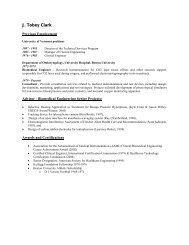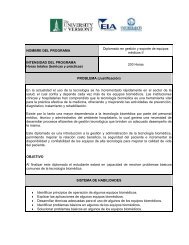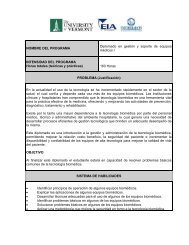Structural Shielding Design and Evaluation for Megavoltage x- and ...
Structural Shielding Design and Evaluation for Megavoltage x- and ...
Structural Shielding Design and Evaluation for Megavoltage x- and ...
Create successful ePaper yourself
Turn your PDF publications into a flip-book with our unique Google optimized e-Paper software.
<strong>Structural</strong> <strong>Shielding</strong> <strong>Design</strong> <strong>and</strong><strong>Evaluation</strong> <strong>for</strong> <strong>Megavoltage</strong> x- <strong>and</strong>Gamma-ray Radiotherapy Facilities
This Report was prepared through a joint ef<strong>for</strong>t of NCRP ScientificCommittee 46-13 on <strong>Design</strong> of Facilities <strong>for</strong> Medical RadiationTherapy <strong>and</strong> the American Association of Physicists in Medicine(AAPM) Task Group 57.James A. Deye, ChairmanJames E. Rodgers, Vice ChairRaymond K. Wu, Vice ChairPeter J. BiggsPatton H. McGinleyRichard C. McCallKenneth R. KaseMarc EdwardsRobert O. GorsonJeffrey H. KleckNisy E. Ipe
This Report addresses the structural shielding design<strong>and</strong> evaluation <strong>for</strong> medical use of megavoltage x- <strong>and</strong>gamma-rays <strong>for</strong> radiotherapy <strong>and</strong> supersedes relatedmaterial in NCRP Report No. 49, <strong>Structural</strong> <strong>Shielding</strong><strong>Design</strong> <strong>and</strong> <strong>Evaluation</strong> <strong>for</strong> Medical Use of X Rays <strong>and</strong>Gamma Rays of Energies Up to 10 MeV, which wasissued in September 1976.The descriptive in<strong>for</strong>mation in NCRP Report No. 49unique to x-ray therapy installations of less than 500kV (Section 6.2) <strong>and</strong> brachytherapy is not included inthis Report <strong>and</strong> that in<strong>for</strong>mation in NCRP Report No. 49<strong>for</strong> those categories is still applicable.Similarly therapy simulators are not covered in thisreport <strong>and</strong> the user is referred to the recent Report 147<strong>for</strong> shielding of imaging facilities.
New Issues since NCRP # 49– New types of equipment with energies above 10 MV,– Many new uses <strong>for</strong> radiotherapy equipment,– Dual energy machines <strong>and</strong> new treatment techniques,– Room designs without mazes,– Varied shielding materials including composites,– More published data on empirical methods.
1) Introduction (purposes, units, basic principles)2) Calculational Methods3) Workload, Use Factor <strong>and</strong> Absorbed-Dose RateConsiderations4) <strong>Structural</strong> Details5) Special Considerations (skyshine, side-scatter,groundshine, activation,ozone, tomotherapy, roboticarms,IORT, Co-60)6) <strong>Shielding</strong> <strong>Evaluation</strong>s (Surveys)7) Examples (calculations)Appendix A. FiguresAppendix B. TablesAppendix C. Neutron Monitoring
Increased data <strong>for</strong>:• neutron production• capture gamma rays• scatter fractions• scatter albedo• activation• laminated barriers• IMRT ‘efficiency’ factors
The quantity recommended in this Report <strong>for</strong> shielding design calculationswhen neutrons, as well as photons, are present is dose equivalent (H).Dose equivalent is defined as the product of the quality factor <strong>for</strong> a particular type ofionizing radiation <strong>and</strong> the absorbed dose (D) [in gray (Gy)] from that type of radiationat a point in tissue (ICRU, 1993). The units of dose equivalent are J kg–1with the special name sievert (Sv).The recommended radiation protection quantity <strong>for</strong> the limitationof exposure to people from sources of radiation is effective dose (E),defined as the sum of the weighted equivalent doses to specific organs or tissues(i.e., each equivalent dose is weighted by the corresponding tissue weighting factor<strong>for</strong> the organ or tissue) (NCRP, 1993).
In this Report, shielding design goals (P) are levels of doseequivalent (H) used in the design calculations <strong>and</strong> evaluation ofbarriers constructed <strong>for</strong> the protection of workers or members of thepublic.<strong>Shielding</strong> design goals (P) are practical values, <strong>for</strong> a singleradiotherapy source or set of sources, that are evaluated at a referencepoint beyond a protective barrier. When used in conjunctionwith the conservatively safe assumptions in this Report, the shieldingdesign goals will ensure that the respective annual values <strong>for</strong> Erecommended in NCRP Report No. 147 (NCRP, 2004)The shielding design goals (P values) in this Report apply onlyto new facilities <strong>and</strong> new construction <strong>and</strong> will not require retrofittingof existing facilities.
Recommendation <strong>for</strong> Controlled Areas:<strong>Shielding</strong> design goal (P) (in dose equivalent):0.1 mSv week–1 (5 mSv y–1)Recommendation <strong>for</strong> Uncontrolled Areas:<strong>Shielding</strong> design goal (P) (in dose equivalent):0.02 mSv week–1 (1 mSv y–1)
The required number (n) of TVLs is given by:And the barrier thickness (t barrier) is given by:Where the first <strong>and</strong> equilibrium TVLs are used to account <strong>for</strong> the spectralchanges as the radiation penetrates the barrier
Gy wk -1Lowenergy1000Highenergy500NCRP #49NCRP # 51< 350 < 250450 400 *Kleck <strong>and</strong> Elsalim (1994)Meckalakos et al (2004)* dual energy machine
The IMRT factor:The ratio of the average monitor unit per unit prescribed absorbed doseneeded <strong>for</strong> IMRT (MUIMRT) <strong>and</strong> the monitor unit per unit absorbed dose<strong>for</strong> conventional treatment (MUconv)~ 2 - 10
use factor (U):
occupancy factor (T):
e-arranging any of the barriertransmission equations, one gets thedose equivalent beyond the barrierW UT B prid 2= H priabsorbed dose dose equivalent
Weekly dose equivalent at the door due to neutron capture gamma rays:
Weekly dose equivalent at the door due to neutrons:
Also true <strong>for</strong> laminated barriers:
Where <strong>for</strong> LOW ENERGY:H Tot = H tr = W UT B 1 B m B 2d 2 <strong>and</strong> H cg = H n = 0For HIGH ENERGY:H Tot + H cg = 2.7 W UT B 1 B m B 2d 2
3.3 Time Averaged Dose-Equivalent RatesWhen designing radiation shielding barriers it is usual to assume that the workloadwill be evenly distributed throughout the year. There<strong>for</strong>e, it is reasonable to designa barrier to meet a weekly value equal to one-fiftieth of the annual shielding designgoal (NCRP, 2004). However, further scaling the shielding design goal toshorter intervals is not appropriate <strong>and</strong> may be incompatible with the ALARAprinciple. Specifically, the use of a measured instantaneous dose-equivalentrate (IDR), with the accelerator operating at maximum output, does notproperly represent the true operating conditions <strong>and</strong> radiation environmentof the facility. It is more useful if the workload <strong>and</strong> use factor are consideredtogether with the IDR when evaluating the adequacy of a barrier.For this purpose, the concept of time averaged dose equivalent rate (TADR) isused in this Report along with the measured or calculated IDR.The TADR is the barrier attenuated dose-equivalent rate averaged over aspecified time or period of operation. TADR is proportional to IDR, <strong>and</strong> dependson values of W <strong>and</strong> U. There are two periods of operation of particular interest toradiation protection, the week <strong>and</strong> the hour.
The U.S. Nuclear Regulatory Commission (NRC) specifies that the doseequivalent in any unrestricted area from external sources not exceed 0.02 mSvin-any-one-hour (NRC, 2005a). Rh derives from the maximum number ofpatient treatments that could possibly be per<strong>for</strong>med in-any-one-hour when thetime <strong>for</strong> setup of the procedure is taken into account.Nmax = maximum number of patient treatments in-anyone-hour with dueconsideration to procedure set-up timeHpt = average dose equivalent per patient treatment at 30 cm beyond thepenetrated barrier
CONSERVATIVE ASSUMPTIONS:>Attenuation of the primary beam by the patient is neglected. The patienttypically attenuates the primary beam by 30 % or more.>>>>The calculations of recommended barrier thickness often assumeperpendicular incidence of the radiation.Leakage radiation from radiotherapy equipment is assumed to be at themaximum value recommendedThe recommended occupancy factors <strong>for</strong> uncontrolled areas are conservativelyhigh.The minimum distance to the occupied area from a shielded wall is assumed tobe 0.3 m.
CONSERVATIVE ASSUMPTIONS:>when data are hard to estimate, such as in the design of acceleratorfacilities that will employ special procedures, safety factors arerecommended>The “two-source rule” (i.e., the procedure when more than one source is involved)is applied whenever separate radiation components are combined to arrive at abarrier thickness. This has been shown to be a conservatively safe assumptionsince the tenth-value layer (TVL) <strong>and</strong> half-value layer (HVL) of the morepenetrating radiation is always used.







